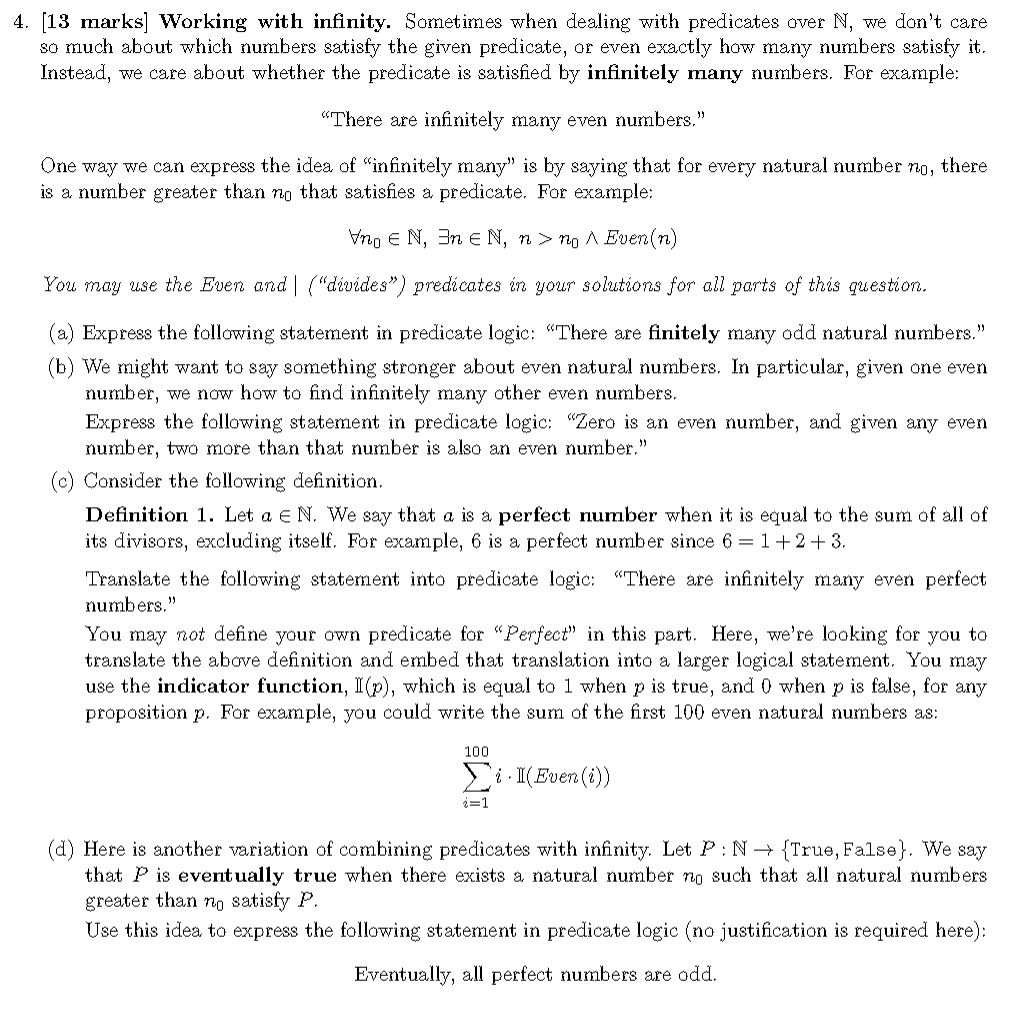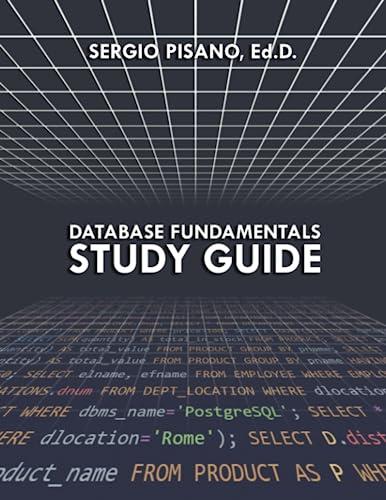Answered step by step
Verified Expert Solution
Question
1 Approved Answer
Many likes guaranteed if the answer is correct and the solution is readable. 4. [13 marks] Working with infinity. Sometimes when dealing with predicates over

Many likes guaranteed if the answer is correct and the solution is readable.
4. [13 marks] Working with infinity. Sometimes when dealing with predicates over N, we don't care so much about which numbers satisfy the given predicate, or even exactly how many numbers satisfy it. Instead, we care about whether the predicate is satisfied by infinitely many numbers. For example: There are infinitely many even numbers." One way we can express the idea of "infinitely many" is by saying that for every natural number no, there is a number greater than no that satisfies a predicate. For example: Vno EN, 3n e N, n > no A Even(n) You may use the Even and| ("divides") predicates in your solutions for all parts of this question. (a) Express the following statement in predicate logic: There are finitely many odd natural numbers." (b) We might want to say something stronger about even natural numbers. In particular, given one even number, we now how to find infinitely many other even numbers. Express the following statement in predicate logic: Zero is an even number, and given any even number, two more than that number is also an even number." (c) Consider the following definition, Definition 1. Let a EN. We say that a is a perfect number when it is equal to the sum of all of its divisors, excluding itself. For example, 6 is a perfect number since 6=1+2+3. Translate the following statement into predicate logic: There are infinitely many even perfect numbers." You may not define your own predicate for "Perfect" in this part. Here, we're looking for you to translate the above definition and embed that translation into a larger logical statement. You may use the indicator function, I(p), which is equal to 1 when p is true, and I when p is false, for any proposition p. For example, you could write the sum of the first 100 even natural numbers as: 100 2.1(Even (i)) i=1 (d) Here is another variation of combining predicates with infinity. Let P:N {True, False}. We say that P is eventually true when there exist a natural number no such that all natural umbers greater than no satisfy P. Use this idea to express the following statement in predicate logic (no justification is required here): Eventually, all perfect numbers are odd. 4. [13 marks] Working with infinity. Sometimes when dealing with predicates over N, we don't care so much about which numbers satisfy the given predicate, or even exactly how many numbers satisfy it. Instead, we care about whether the predicate is satisfied by infinitely many numbers. For example: There are infinitely many even numbers." One way we can express the idea of "infinitely many" is by saying that for every natural number no, there is a number greater than no that satisfies a predicate. For example: Vno EN, 3n e N, n > no A Even(n) You may use the Even and| ("divides") predicates in your solutions for all parts of this question. (a) Express the following statement in predicate logic: There are finitely many odd natural numbers." (b) We might want to say something stronger about even natural numbers. In particular, given one even number, we now how to find infinitely many other even numbers. Express the following statement in predicate logic: Zero is an even number, and given any even number, two more than that number is also an even number." (c) Consider the following definition, Definition 1. Let a EN. We say that a is a perfect number when it is equal to the sum of all of its divisors, excluding itself. For example, 6 is a perfect number since 6=1+2+3. Translate the following statement into predicate logic: There are infinitely many even perfect numbers." You may not define your own predicate for "Perfect" in this part. Here, we're looking for you to translate the above definition and embed that translation into a larger logical statement. You may use the indicator function, I(p), which is equal to 1 when p is true, and I when p is false, for any proposition p. For example, you could write the sum of the first 100 even natural numbers as: 100 2.1(Even (i)) i=1 (d) Here is another variation of combining predicates with infinity. Let P:N {True, False}. We say that P is eventually true when there exist a natural number no such that all natural umbers greater than no satisfy P. Use this idea to express the following statement in predicate logic (no justification is required here): Eventually, all perfect numbers are oddStep by Step Solution
There are 3 Steps involved in it
Step: 1

Get Instant Access to Expert-Tailored Solutions
See step-by-step solutions with expert insights and AI powered tools for academic success
Step: 2

Step: 3

Ace Your Homework with AI
Get the answers you need in no time with our AI-driven, step-by-step assistance
Get Started


